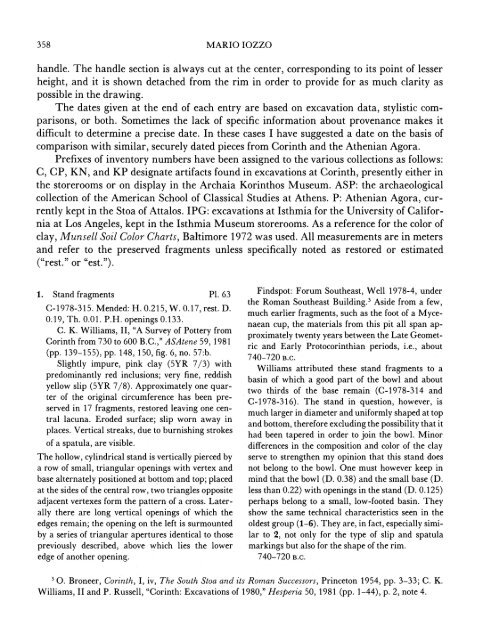f - The American School of Classical Studies at Athens
f - The American School of Classical Studies at Athens
f - The American School of Classical Studies at Athens
Create successful ePaper yourself
Turn your PDF publications into a flip-book with our unique Google optimized e-Paper software.
358 MARIO IOZZO<br />
handle. <strong>The</strong> handle section is always cut <strong>at</strong> the center, corresponding to its point <strong>of</strong> lesser<br />
height, and it is shown detached from the rim in order to provide for as much clarity as<br />
possible in the drawing.<br />
<strong>The</strong> d<strong>at</strong>es given <strong>at</strong> the end <strong>of</strong> each entry are based on excav<strong>at</strong>ion d<strong>at</strong>a, stylistic comparisons,<br />
or both. Sometimes the lack <strong>of</strong> specific inform<strong>at</strong>ion about provenance makes it<br />
difficult to determine a precise d<strong>at</strong>e. In these cases I have suggested a d<strong>at</strong>e on the basis <strong>of</strong><br />
comparison with similar, securely d<strong>at</strong>ed pieces from Corinth and the Athenian Agora.<br />
Prefixes <strong>of</strong> inventory numbers have been assigned to the various collections as follows:<br />
C, CP, KN, and KP design<strong>at</strong>e artifacts found in excav<strong>at</strong>ions <strong>at</strong> Corinth, presently either in<br />
the storerooms or on display in the Archaia Korinthos Museum. ASP: the archaeological<br />
collection <strong>of</strong> the <strong>American</strong> <strong>School</strong> <strong>of</strong> <strong>Classical</strong> <strong>Studies</strong> <strong>at</strong> <strong>Athens</strong>. P: Athenian Agora, currently<br />
kept in the Stoa <strong>of</strong> Attalos. IPG: excav<strong>at</strong>ions <strong>at</strong> Isthmia for the University <strong>of</strong> California<br />
<strong>at</strong> Los Angeles, kept in the Isthmia Museum storerooms. As a reference for the color <strong>of</strong><br />
clay, Munsell Soil Color Charts, Baltimore 1972 was used. All measurements are in meters<br />
and refer to the preserved fragments unless specifically noted as restored or estim<strong>at</strong>ed<br />
("rest." or "est.").<br />
1. Stand fragments P1. 63<br />
C-1978-315. Mended: H. 0.215, W. 0.17, rest. D.<br />
0.19, Th. 0.01. P.H. openings 0.133.<br />
C. K. Williams, II, "A Survey <strong>of</strong> Pottery from<br />
Corinth from 730 to 600 B.C.," ASAtene 59, 1981<br />
(pp. 139-155), pp. 148, 150, fig. 6, no. 57:b.<br />
Slightly impure, pink clay (5YR 7/3) with<br />
predominantly red inclusions; very fine, reddish<br />
yellow slip (5YR 7/8). Approxim<strong>at</strong>ely one quar-<br />
ter <strong>of</strong> the original circumference has been pre-<br />
served in 17 fragments, restored leaving one cen-<br />
tral lacuna. Eroded surface; slip worn away in<br />
places. Vertical streaks, due to burnishing strokes<br />
<strong>of</strong> a sp<strong>at</strong>ula, are visible.<br />
<strong>The</strong> hollow, cylindrical stand is vertically pierced by<br />
a row <strong>of</strong> small, triangular openings with vertex and<br />
base altern<strong>at</strong>ely positioned <strong>at</strong> bottom and top; placed<br />
<strong>at</strong> the sides <strong>of</strong> the central row, two triangles opposite<br />
adjacent vertexes form the p<strong>at</strong>tern <strong>of</strong> a cross. L<strong>at</strong>er-<br />
ally there are long vertical openings <strong>of</strong> which the<br />
edges remain; the opening on the left is surmounted<br />
by a series <strong>of</strong> triangular apertures identical to those<br />
previously described, above which lies the lower<br />
edge <strong>of</strong> another opening.<br />
Findspot: Forum Southeast, Well 1978-4, under<br />
the Roman Southeast Building.3 Aside from a few,<br />
much earlier fragments, such as the foot <strong>of</strong> a Myce-<br />
naean cup, the m<strong>at</strong>erials from this pit all span ap-<br />
proxim<strong>at</strong>ely twenty years between the L<strong>at</strong>e Geomet-<br />
ric and Early Protocorinthian periods, i.e., about<br />
740-720 B.C.<br />
Williams <strong>at</strong>tributed these stand fragments to a<br />
basin <strong>of</strong> which a good part <strong>of</strong> the bowl and about<br />
two thirds <strong>of</strong> the base remain (C-1978-314 and<br />
C-1978-316). <strong>The</strong> stand in question, however, is<br />
much larger in diameter and uniformly shaped <strong>at</strong> top<br />
and bottom, therefore excluding the possibility th<strong>at</strong> it<br />
had been tapered in order to join the bowl. Minor<br />
differences in the composition and color <strong>of</strong> the clay<br />
serve to strengthen my opinion th<strong>at</strong> this stand does<br />
not belong to the bowl. One must however keep in<br />
mind th<strong>at</strong> the bowl (D. 0.38) and the small base (D.<br />
less than 0.22) with openings in the stand (D. 0.125)<br />
perhaps belong to a small, low-footed basin. <strong>The</strong>y<br />
show the same technical characteristics seen in the<br />
oldest group (1-6). <strong>The</strong>y are, in fact, especially simi-<br />
lar to 2, not only for the type <strong>of</strong> slip and sp<strong>at</strong>ula<br />
markings but also for the shape <strong>of</strong> the rim.<br />
740-720 B.C.<br />
0<br />
O. Broneer, Corinth, I, iv, <strong>The</strong> South Stoa and its Roman Successors, Princeton 1954, pp. 3-33; C. K.<br />
Williams, II and P. Russell, "Corinth: Excav<strong>at</strong>ions <strong>of</strong> 1980," Hesperia 50, 1981 (pp. 1-44), p. 2, note 4.

















